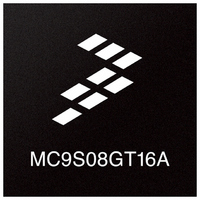MC9S08GT16ACFDE Freescale Semiconductor, MC9S08GT16ACFDE Datasheet - Page 276

MC9S08GT16ACFDE
Manufacturer Part Number
MC9S08GT16ACFDE
Description
IC MCU 16K FLASH 2K RAM 48-QFN
Manufacturer
Freescale Semiconductor
Series
HCS08r
Datasheet
1.MC9S08GT8ACFBER.pdf
(300 pages)
Specifications of MC9S08GT16ACFDE
Core Processor
HCS08
Core Size
8-Bit
Speed
40MHz
Connectivity
I²C, SCI, SPI
Peripherals
LVD, POR, PWM, WDT
Number Of I /o
39
Program Memory Size
16KB (16K x 8)
Program Memory Type
FLASH
Ram Size
2K x 8
Voltage - Supply (vcc/vdd)
1.8 V ~ 3.6 V
Data Converters
A/D 8x10b
Oscillator Type
Internal
Operating Temperature
-40°C ~ 85°C
Package / Case
48-QFN
Cpu Family
HCS08
Device Core Size
8b
Frequency (max)
40MHz
Interface Type
I2C/SCI/SPI
Total Internal Ram Size
2KB
# I/os (max)
39
Operating Supply Voltage (typ)
2.5/3.3V
Operating Supply Voltage (max)
3.6V
Operating Supply Voltage (min)
1.8V
On-chip Adc
8-chx10-bit
Instruction Set Architecture
CISC
Operating Temp Range
-40C to 85C
Operating Temperature Classification
Industrial
Mounting
Surface Mount
Pin Count
48
Package Type
QFN EP
Processor Series
S08GT
Core
HCS08
Data Bus Width
8 bit
Data Ram Size
2 KB
Maximum Clock Frequency
20 MHz
Number Of Programmable I/os
39
Operating Supply Voltage
3.6 V
Maximum Operating Temperature
+ 85 C
Mounting Style
SMD/SMT
3rd Party Development Tools
EWS08
Development Tools By Supplier
M68EVB908GB60E, M68DEMO908GB60E
Minimum Operating Temperature
- 40 C
For Use With
M68DEMO908GB60E - BOARD DEMO MC9S08GB60M68EVB908GB60E - BOARD EVAL FOR MC9S08GB60
Lead Free Status / RoHS Status
Lead free / RoHS Compliant
Eeprom Size
-
Lead Free Status / Rohs Status
Compliant
- Current page: 276 of 300
- Download datasheet (2Mb)
Electrical Characteristics
A.10
This section describes ac timing characteristics for each peripheral system. For detailed information about
how clocks for the bus are generated, see
276
1
2
3
4
5
6
7
8
Self-clocked mode frequency is the frequency that the DCO generates when the FLL is open-loop.
Loss of reference frequency is the reference frequency detected internally, which transitions the ICG into self-clocked
mode if it is not in the desired range.
Loss of DCO frequency is the DCO frequency detected internally, which transitions the ICG into FLL bypassed external
mode (if an external reference exists) if it is not in the desired range.
This parameter is characterized before qualification rather than 100% tested.
Proper PC board layout procedures must be followed to achieve specifications.
This specification applies to the period of time required for the FLL to lock after entering FLL engaged internal or external
modes. If a crystal/resonator is being used as the reference, this specification assumes it is already running.
Jitter is the average deviation from the programmed frequency measured over the specified interval at maximum f
Measurements are made with the device powered by filtered supplies and clocked by a stable external clock signal. Noise
injected into the FLL circuitry via V
percentage for a given interval.
See
Figure A-10
AC Characteristics
–60
Figure A-10. Internal Oscillator Deviation from Trimmed Frequency
–40
DDA
–20
MC9S08GT16A/GT8A Data Sheet, Rev. 1
and V
TEMPERATURE (°C)
–0.1
0.1
SSA
0
Chapter 9, “Internal Clock Generator
and variation in crystal oscillator frequency increase the C
–0.2
–0.3
–0.4
–0.5
–0.6
20
40
60
80
(S08ICGV4).”
2 V
3 V
Freescale Semiconductor
100
Jitter
120
ICGOUT
.
Related parts for MC9S08GT16ACFDE
Image
Part Number
Description
Manufacturer
Datasheet
Request
R
Part Number:
Description:
Manufacturer:
Freescale Semiconductor, Inc
Datasheet:
Part Number:
Description:
Manufacturer:
Freescale Semiconductor, Inc
Datasheet:
Part Number:
Description:
Manufacturer:
Freescale Semiconductor, Inc
Datasheet:
Part Number:
Description:
Manufacturer:
Freescale Semiconductor, Inc
Datasheet:
Part Number:
Description:
Manufacturer:
Freescale Semiconductor, Inc
Datasheet:
Part Number:
Description:
Manufacturer:
Freescale Semiconductor, Inc
Datasheet:
Part Number:
Description:
Manufacturer:
Freescale Semiconductor, Inc
Datasheet:
Part Number:
Description:
Manufacturer:
Freescale Semiconductor, Inc
Datasheet:
Part Number:
Description:
Manufacturer:
Freescale Semiconductor, Inc
Datasheet:
Part Number:
Description:
Manufacturer:
Freescale Semiconductor, Inc
Datasheet:
Part Number:
Description:
Manufacturer:
Freescale Semiconductor, Inc
Datasheet:
Part Number:
Description:
Manufacturer:
Freescale Semiconductor, Inc
Datasheet:
Part Number:
Description:
Manufacturer:
Freescale Semiconductor, Inc
Datasheet:
Part Number:
Description:
Manufacturer:
Freescale Semiconductor, Inc
Datasheet:
Part Number:
Description:
Manufacturer:
Freescale Semiconductor, Inc
Datasheet:










